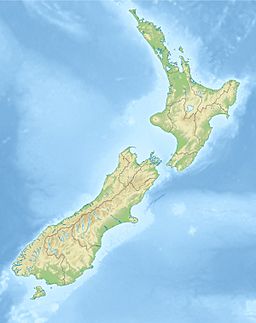Lake Harihari facts for kids
Quick facts for kids Lake Harihari |
|
|---|---|
| Location | Waitomo District, Waikato region, North Island |
| Coordinates | 38°12′35″S 174°43′23″E / 38.20972°S 174.72306°E |
| Lake type | oligomesotrophic lake |
| Primary outflows | seepage |
| Catchment area | 134 ha (330 acres) |
| Basin countries | New Zealand |
| Surface area | 18.39 ha (45.4 acres) |
| Max. depth | 9 m (30 ft) |
| Surface elevation | 20 m (66 ft) |
Lake Harihari is a special lake in New Zealand. It is located about 10 kilometers south of Kawhia in the Waikato region. This lake is unique because it is held back by sand dunes. It has some of the cleanest water among all the dune lakes in the Waikato area. People think its clean water is because it is far away from busy places.
Contents
How Lake Harihari Was Formed
Lake Harihari is a "dune-dammed" lake. This means it was created when sand dunes blocked a valley or a stream, causing water to collect and form a lake. Even though the dunes hold the lake, a small stream can flow out of it during very wet weather.
Underneath these sand dunes, there is a type of rock called greywacke sandstone. This hard rock makes up most of the coastline in this area. These rocks are very old, forming during the Late Triassic period.
The land under the lake belongs to the Taharoa Lakes Trust. The land around the lake is privately owned. Experts say Lake Harihari is one of the best shallow lakes in the region for its water quality. It is considered very important for the environment.
Amazing Animals and Plants
Lake Harihari has the best water quality of all the Waikato dune lakes. Its water is described as "oligomesotrophic," which means it is very clean and clear. This clean water helps many different plants and animals to live there.
People are working to keep the lake healthy. They have put up fences to protect the lake's edges. They have also planted about 10,000 new plants around the lake. These plants are chosen to handle the strong coastal winds and dry summers.
What Lives in the Lake?
Many interesting creatures live in Lake Harihari. You might find dabchicks, which are small diving birds. The lake is also home to many shells and a large population of freshwater mussels. You can also find freshwater sponges and native snails.
The lake has native fish, including the common bully and New Zealand smelt. The health of the lake can be seen by the tiny animals called zooplankton that live in it. These include different types of rotifers, Bosmina meridionalis, Calamoecia lucasi, and Mesocyclops leuckarti.
Lake Harihari has the fewest non-native zooplankton compared to other Waikato lakes. However, there are some unwanted plants like willow, pampas, kikuyu, and Canadian pondweed. Efforts are made to control these weeds.
History Around the Lake
Archaeological maps show that people have lived around Lake Harihari for a very long time. There are about a dozen historical sites found near the lake. These sites tell us about the past and the people who lived there.


